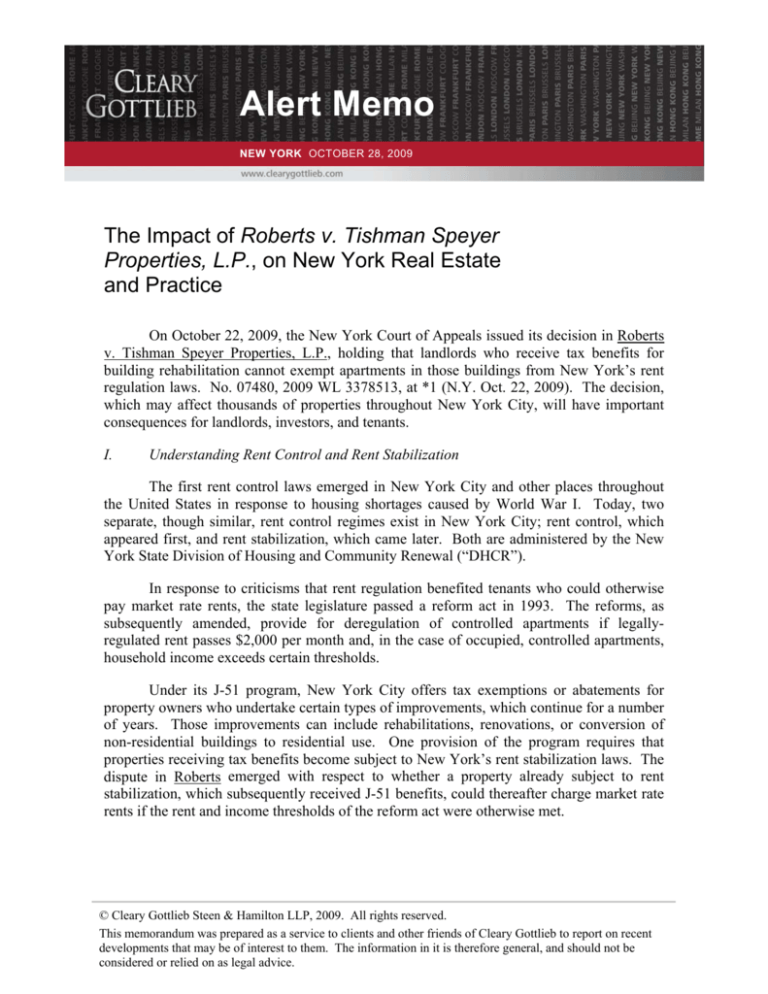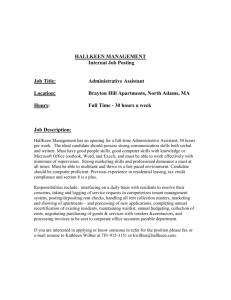
Alert Memo
NEW YORK OCTOBER 28, 2009
The Impact of Roberts v. Tishman Speyer
Properties, L.P., on New York Real Estate
and Practice
On October 22, 2009, the New York Court of Appeals issued its decision in Roberts
v. Tishman Speyer Properties, L.P., holding that landlords who receive tax benefits for
building rehabilitation cannot exempt apartments in those buildings from New York’s rent
regulation laws. No. 07480, 2009 WL 3378513, at *1 (N.Y. Oct. 22, 2009). The decision,
which may affect thousands of properties throughout New York City, will have important
consequences for landlords, investors, and tenants.
I.
Understanding Rent Control and Rent Stabilization
The first rent control laws emerged in New York City and other places throughout
the United States in response to housing shortages caused by World War I. Today, two
separate, though similar, rent control regimes exist in New York City; rent control, which
appeared first, and rent stabilization, which came later. Both are administered by the New
York State Division of Housing and Community Renewal (“DHCR”).
In response to criticisms that rent regulation benefited tenants who could otherwise
pay market rate rents, the state legislature passed a reform act in 1993. The reforms, as
subsequently amended, provide for deregulation of controlled apartments if legallyregulated rent passes $2,000 per month and, in the case of occupied, controlled apartments,
household income exceeds certain thresholds.
Under its J-51 program, New York City offers tax exemptions or abatements for
property owners who undertake certain types of improvements, which continue for a number
of years. Those improvements can include rehabilitations, renovations, or conversion of
non-residential buildings to residential use. One provision of the program requires that
properties receiving tax benefits become subject to New York’s rent stabilization laws. The
dispute in Roberts emerged with respect to whether a property already subject to rent
stabilization, which subsequently received J-51 benefits, could thereafter charge market rate
rents if the rent and income thresholds of the reform act were otherwise met.
© Cleary Gottlieb Steen & Hamilton LLP, 2009. All rights reserved.
This memorandum was prepared as a service to clients and other friends of Cleary Gottlieb to report on recent
developments that may be of interest to them. The information in it is therefore general, and should not be
considered or relied on as legal advice.
II.
The Court’s Decision in Roberts
Roberts begins in the heady days of 2006, when a joint venture between Tishman
Speyer Properties and BlackRock Inc. paid $5.4 billion for Peter Cooper Village and
Stuyvesant Town. At that time, the purchasers believed that they could convert the
complex, which had originally been built to house WWII veterans and their families, into
luxury apartment buildings. Income from the property was projected to triple between 2006
and 2011, as the investors made improvements and moved many of the apartments from rent
regulation to market rates.
After the new property owners began deregulating apartments, several tenants
brought suit, claiming that the decontrol provisions of New York’s rent stabilization laws
could not be taken advantage of by the property owners because they were simultaneously
receiving tax benefits under the J-51 program. Metlife, the prior owner of the complex,
began receiving J-51 benefits in 1992, although rent stabilization throughout the complex
began in 1974. J-51 benefits were expected to continue through 2017/2018.
The defendants argued that language in the relevant laws was written so that
deregulation would be prohibited only if apartments became subject to rent stabilization
laws because they received J-51 tax benefits. That is, defendants argued that rent
deregulation was permissible because they took advantage of the J-51 program after
apartments in both complexes became rent-regulated. Defendants also argued that DHCR
had adopted their position on exemptions to New York’s rent regulation laws at least as
early as 1996 and that the agency’s opinion on the matter was entitled to deference by the
New York courts.
The Court of Appeals, New York’s highest court, ruled in favor of the tenants. In a
4-2 opinion, it found that the defendants’ interpretation of the relevant statutes conflicted
with the most natural reading of them. The court determined that the distinction defendants
wanted to draw, between properties that became stabilized prior to receiving J-51 benefits,
and those that became stabilized “as a condition of receiving J-51 benefits,” was not
supported by the text or legislative intent. The court also rejected the argument that the
defendants and the state agency responsible for administering New York’s rent control laws
had interpreted the laws similarly, or that the agency’s interpretation of the law would be
entitled to much deference anyway.
III.
The Impact of the Decision
The immediate effect of the court’s decision is hard to determine. The court left
open for the trial court to decide, among other things, retroactivity, class certification and the
measure of damages. For example, is the appropriate remedy payment of damages to
tenants or disgorgement of tax benefits received under the J-51 program? Yet, the longerterm consequences of the decision may be more easily discernable.
2
With respect to Stuyvesant Town’s owners, it seems that their financial position just
became more precarious than it was prior to the decision. Without the ability to raise rents,
it will be very difficult for the owners to raise enough capital to meet the payments on the
debt undertaken to purchase the development during New York’s property boom.
Combined with the softening of the real estate market in New York, the value of their
investment has fallen by more than half according to published reports, 1 and projections that
the property would be worth $7 billion within five years of the purchase price now seem
highly unlikely.
Additionally, it seems clear that this decision could have a profound effect on many
landlords throughout the city who have received J-51 tax benefits while also moving
apartments out of rent-regulation as they navigate a period of uncertainty while the lower
court takes up the remaining issues in the case. 2 Certainly, their lenders and investors
should begin thinking about their possible exposure as well.
Will projects in the pipeline, already facing daunting market conditions, be put under
further strain? Will landlords forgo benefits under the tax abatement program entirely,
opting instead to pursue rent decontrol? Will the decision force another look at the efficacy
of rent regulation?
Whether the decision turns out to be as calamitous for landlords (and the New York
real estate market generally) as the defendants argued at trial remains to be seen.
Please feel free to contact any of your regular contacts at the firm or any of our
partners, counsel or senior attorneys listed under Real Estate in the Practices section of our
website (http://www.clearygottlieb.com) if you have any questions.
CLEARY GOTTLIEB STEEN & HAMILTON LLP
1
See, e.g., Lingling Wei & Craig Karmin, An Apartment Complex Teeters, WALL ST. J., Oct. 15, 2009, at
M12.
2
An article in the New York Times noted that up to 80,000 apartment buildings in New York could be affected
by this decision. Charles V. Bagli, Court Deals Blow to Owners of Huge Apartment Complex, N.Y. TIMES,
Oct. 23, 2009, at A1.
3
Office Locations
FRANKFURT
Main Tower
Neue Mainzer Strasse 52
60311 Frankfurt am Main, Germany
49 69 97103 0
49 69 97103 199 Fax
NEW YORK
One Liberty Plaza
New York, NY 10006-1470
1 212 225 2000
1 212 225 3999 Fax
WASHINGTON
2000 Pennsylvania Avenue, NW
Washington, DC 20006-1801
1 202 974 1500
1 202 974 1999 Fax
COLOGNE
Theodor-Heuss-Ring 9
50668 Cologne, Germany
49 221 80040 0
49 221 80040 199 Fax
PARIS
12, rue de Tilsitt
75008 Paris, France
33 1 40 74 68 00
33 1 40 74 68 88 Fax
ROME
Piazza di Spagna 15
00187 Rome, Italy
39 06 69 52 21
39 06 69 20 06 65 Fax
BRUSSELS
Rue de la Loi 57
1040 Brussels, Belgium
32 2 287 2000
32 2 231 1661 Fax
MILAN
Via San Paolo 7
20121 Milan, Italy
39 02 72 60 81
39 02 86 98 44 40 Fax
LONDON
City Place House
55 Basinghall Street
London EC2V 5EH, England
44 20 7614 2200
44 20 7600 1698 Fax
HONG KONG
Bank of China Tower
One Garden Road
Hong Kong
852 2521 4122
852 2845 9026 Fax
MOSCOW
Cleary Gottlieb Steen & Hamilton LLP
CGS&H Limited Liability Company
Paveletskaya Square 2/3
Moscow, Russia 115054
7 495 660 8500
7 495 660 8505 Fax
BEIJING
Twin Towers – West
12 B Jianguomen Wai Da Jie
Chaoyang District
Beijing 100022, China
86 10 5920 1000
86 10 5879 3902 Fax
www.clearygottlieb.com










